Adsorption Characteristics and Potential of Olive Cake Alkali Residues for Biodiesel Purification
Abstract
1. Introduction
2. Materials and Methods
2.1. Biosorbent and Biodiesel Preparation
2.2. Biodiesel Purification
2.2.1. Wet Purification
2.2.2. Dry Purification
2.3. Adsorption Isotherms
2.4. Oil and Biodiesel Characterization
2.5. Isotherm Modeling
2.5.1. Langmuir Isotherm Model
2.5.2. Freundlich Isotherm Model
2.5.3. Temkin Isotherm
2.6. Statistical and Error Analysis
3. Results and Discussion
3.1. WVO and Crude Biodiesel Properties
3.2. Comparison of Biodiesel Purification Using Olive Cake Alkyl Residues with Other Adsorbents
3.3. Reusability of the Adsorbent
3.4. Adsorption Isotherms
4. Conclusions
Author Contributions
Funding
Conflicts of Interest
References
- Dash, S.K.; Lingfa, P. A Review on Production of Biodiesel Using Catalyzed Transesterification; AIP Publishing LLC: Melville, NY, USA, 2017; Volume 1859, p. 020100. [Google Scholar]
- Mishra, V.K.; Goswami, R. A review of production, properties and advantages of biodiesel. Biofuels 2018, 9, 273–289. [Google Scholar] [CrossRef]
- Sandouqa, A.; Al-Hamamre, Z.; Asfar, J. Preparation and performance investigation of a lignin-based solid acid catalyst manufactured from olive cake for biodiesel production. Renew. Energy 2019, 132, 667–682. [Google Scholar] [CrossRef]
- Chozhavendhan, S.; Singh, M.V.P.; Fransila, B.; Kumar, R.P.; Devi, G.K. A review on influencing parameters of biodiesel production and purification processes. Curr. Res. Green Sustain. Chem. 2020, 1–2, 1–6. [Google Scholar] [CrossRef]
- Fonseca, J.M.; Teleken, J.G.; Almeida, V.d.C.; Silva, C.d. Biodiesel from waste frying oils: Methods of production and purification. Energy Convers. Manag. 2019, 184, 205–218. [Google Scholar] [CrossRef]
- Salameh, T.; Tawalbeh, M.; Al-Shannag, M.; Saidan, M.; Melhem, K.B.; Alkasrawi, M. Energy saving in the process of bioethanol production from renewable paper mill sludge. Energy 2020, 196, 117085. [Google Scholar] [CrossRef]
- Atadashi, I.M.; Aroua, M.K.; Aziz, A.A. Biodiesel separation and purification: A review. Renew. Energy 2011, 36, 437–443. [Google Scholar] [CrossRef]
- Baroutian, S.; Shahbaz, K.; Mjalli, S.F.; Alnashef, M.I.; Hashim, A.M. Adsorptive removal of residual catalyst from palm biodiesel: Application of response surface methodology. Hem. Ind. 2012, 66, 373–380. [Google Scholar] [CrossRef]
- Šalić, A.; Tušek, A.J.; Gojun, M.; Zelić, B. Biodiesel purification in microextractors: Choline chloride based deep eutectic solvents vs. water. Sep. Purif. Technol. 2020, 242, 116783. [Google Scholar] [CrossRef]
- Stojković, I.J.; Stamenković, O.S.; Povrenović, D.S.; Veljković, V.B. Purification technologies for crude biodiesel obtained by alkali-catalyzed transesterification. Renew. Sustain. Energy Rev. 2014, 32, 1–15. [Google Scholar] [CrossRef]
- Wall, J.; Van Gerpen, J.; Thompson, J. Soap and glycerin removal from biodiesel using waterless processes. Trans. ASABE 2011, 54, 535–541. [Google Scholar] [CrossRef]
- Atadashi, I.M.; Aroua, M.K.; Aziz, A.R.A.; Sulaiman, N.M.N. High quality biodiesel obtained through membrane technology. J. Membr. Sci. 2012, 421–422, 154–164. [Google Scholar] [CrossRef]
- Manuale, D.L.; Greco, E.; Clementz, A.; Torres, G.C.; Vera, C.R.; Yori, J.C. Biodiesel purification in one single stage using silica as adsorbent. Chem. Eng. J. 2014, 256, 372–379. [Google Scholar] [CrossRef]
- Manuale, D.L.; Mazzieri, V.M.; Torres, G.; Vera, C.R.; Yori, J.C. Non-catalytic biodiesel process with adsorption-based refining. Fuel 2011, 90, 1188–1196. [Google Scholar] [CrossRef]
- Faccini, C.S.; Cunha, M.E.d.; Moraes, M.S.A.; Krause, L.C.; Manique, M.C.; Rodrigues, M.R.A.; Benvenutti, E.V.; Caramão, E.B. Dry washing in biodiesel purification: A comparative study of adsorbents. J. Braz. Chem. Soc. 2011, 22, 558–563. [Google Scholar] [CrossRef]
- He, H.; Guo, X.; Zhu, S. Comparison of membrane extraction with traditional extraction methods for biodiesel production. J. Am. Oil Chem. Soc. 2006, 83, 457–460. [Google Scholar] [CrossRef]
- Banga, S.; Varshney, P.; Kumar, N.; Pal, M. Optimization of parameters for purification of jatropha curcas based biodiesel using organic adsorbents. Int. J. Renew. Energy Res. (IJRER) 2014, 4, 598–603. [Google Scholar]
- Okumuş, Z.Ç.; Doğan, T.H.; Temur, H. Removal of water by using cationic resin during biodiesel purification. Renew. Energy 2019, 143, 47–51. [Google Scholar] [CrossRef]
- Rudiyanto, B.; Andrianto, M.; Susmiati, Y.; Pambudi, N.A.; Riyanto. Optimization and Validation of Hydrated Magnesium Silicate on Dry Washing Purification Biodiesel Using Response Surface Methodology. Energy Procedia 2019, 158, 333–338. [Google Scholar] [CrossRef]
- Schabort, C.; Visser, H.; Venter, R.; Marx, S. Biodiesel production from butter factory effluent. Afr. J. Biotechnol. 2014, 13, 897–904. [Google Scholar]
- Sim, S.F.; Lee, T.Z.E.; Lu, N.A.L.M.I.; Mohamed, M. Modified coconut copra residues as a low cost biosorbent for adsorption of humic substances from peat swamp runoff. BioResources 2014, 9, 952–968. [Google Scholar] [CrossRef][Green Version]
- Saleh, J.; Dube, M.A.; Tremblay, A.Y. Effect of soap, methanol, and water on glycerol particle size in biodiesel purification. Energy Fuels 2010, 24, 6179–6186. [Google Scholar] [CrossRef]
- Avinash, A.; Murugesan, A. Judicious Recycling of Biobased Adsorbents for Biodiesel Purification: A Critical Review. Environ. Prog. Sustain. Energy 2019, 38, e13077. [Google Scholar] [CrossRef]
- Fadhil, A.B.; Dheyab, M.M.; Abdul-Qader, A.-Q.Y. Purification of biodiesel using activated carbons produced from spent tea waste. J. Assoc. Arab Univ. Basic Appl. Sci. 2012, 11, 45–49. [Google Scholar] [CrossRef]
- Rachmat, D.; Agustin, A.D.; Risanti, D.D. Purification of Biodiesel Using Activated Carbon Produced from Cocoa Pod Husk. E3s Web Conf. 2018, 42. [Google Scholar] [CrossRef]
- Marwaha, A.; Rosha, P.; Mohapatra, S.K.; Mahla, S.K.; Dhir, A. Waste materials as potential catalysts for biodiesel production: Current state and future scope. Fuel Process. Technol. 2018, 181, 175–186. [Google Scholar] [CrossRef]
- Jun, K.C.; Abdul Raman, A.A.; Buthiyappan, A. Treatment of oil refinery effluent using bio-adsorbent developed from activated palm kernel shell and zeolite. RSC Adv. 2020, 10, 24079–24094. [Google Scholar] [CrossRef]
- Gomes, M.G.; Santos, D.Q.; Morais, L.C.d.; Pasquini, D. Purification of biodiesel by dry washing, employing starch and cellulose as natural adsorbents. Fuel 2015, 155, 1–6. [Google Scholar] [CrossRef]
- Noori, M.S.; Karimi, K. Chemical and structural analysis of alkali pretreated pinewood for efficient ethanol production. RSC Adv. 2016, 6, 65683–65690. [Google Scholar] [CrossRef]
- Noori, M.S.; Karimi, K. Detailed study of efficient ethanol production from elmwood by alkali pretreatment. Biochem. Eng. J. 2016, 105, 197–204. [Google Scholar] [CrossRef]
- Espadas-Aldana, G.; Vialle, C.; Belaud, J.-P.; Vaca-Garcia, C.; Sablayrolles, C. Analysis and trends for Life Cycle Assessment of olive oil production. Sustain. Prod. Consum. 2019, 19, 216–230. [Google Scholar] [CrossRef]
- Khounani, Z.; Hosseinzadeh-Bandbafha, H.; Moustakas, K.; Talebi, A.F.; Goli, S.A.H.; Rajaeifar, M.A.; Khoshnevisan, B.; Jouzani, G.S.; Peng, W.; Kim, K.-H.; et al. Environmental life cycle assessment of different biorefinery platforms valorizing olive wastes to biofuel, phosphate salts, natural antioxidant, and an oxygenated fuel additive (triacetin). J. Clean. Prod. 2021, 278, 123916. [Google Scholar] [CrossRef]
- Lafka, T.-I.; Lazou, A.E.; Sinanoglou, V.J.; Lazos, E.S. Phenolic and antioxidant potential of olive oil mill wastes. Food Chem. 2011, 125, 92–98. [Google Scholar] [CrossRef]
- Al-Addous, M.; Alnaief, M.; Class, C.; Nsair, A.; Kuchta, K.; Alkasrawi, M. Technical Possibilities of Biogas Production from Olive and Date Waste in Jordan. BioResources 2017, 12, 9383–9395. [Google Scholar]
- Aragón, J.; Palancar, M. Improlive 2000. In Present and Future of Alperujo; Editorial Complutense: Madrid, Spain, 2001. [Google Scholar]
- Buckland, G.; González, C.A. Chapter 72-Trends in Olive Oil Production, Supply and Consumption in Mediterranean Countries from 1961 to the Present Day. In Olives and Olive Oil in Health and Disease Prevention; Preedy, V.R., Watson, R.R., Eds.; Academic Press: San Diego, CA, USA, 2010; pp. 689–698. ISBN 978-0-12-374420-3. [Google Scholar]
- Al-Widyan, M.I.; Tashtoush, G.; Khdair, A.I. Briquettes of olive cake as a potential source of thermal energy. J. Solid Waste Technol. Manag. 2002, 28, 51–59. [Google Scholar]
- Gálvez-Pérez, A.; Pérez, A.; Calero, M.; Martín-Lara, M.A.; Blázquez, G. Integral exploitation from olive cake for energy production in a biorefinery scheme. Process. Saf. Environ. Prot. 2019, 131, 135–143. [Google Scholar] [CrossRef]
- Fernández-González, R.; Martín-Lara, M.A.; Blázquez, G.; Tenorio, G.; Calero, M. Hydrolyzed olive cake as novel adsorbent for copper removal from fertilizer industry wastewater. J. Clean. Prod. 2020, 268, 121935. [Google Scholar] [CrossRef]
- Song, S.; Saman, N.; Johari, K.; Mat, H. Removal of mercury (II) from aqueous solution by using rice residues. J. Teknol. 2013, 63. [Google Scholar] [CrossRef]
- Gautam, R.K.; Mudhoo, A.; Lofrano, G.; Chattopadhyaya, M.C. Biomass-derived biosorbents for metal ions sequestration: Adsorbent modification and activation methods and adsorbent regeneration. J. Environ. Chem. Eng. 2014, 2, 239–259. [Google Scholar] [CrossRef]
- Velazquez-Jimenez, L.H.; Pavlick, A.; Rangel-Mendez, J.R. Chemical characterization of raw and treated agave bagasse and its potential as adsorbent of metal cations from water. Ind. Crop. Prod. 2013, 43, 200–206. [Google Scholar] [CrossRef]
- Kong, Z.; Li, X.; Tian, J.; Yang, J.; Sun, S. Comparative study on the adsorption capacity of raw and modified litchi pericarp for removing Cu (II) from solutions. J. Environ. Manag. 2014, 134, 109–116. [Google Scholar] [CrossRef] [PubMed]
- Rafatullah, M.; Sulaiman, O.; Hashim, R.; Ahmad, A. Adsorption of methylene blue on low-cost adsorbents: A review. J. Hazard. Mater. 2010, 177, 70–80. [Google Scholar] [CrossRef] [PubMed]
- Hor, K.Y.; Chee, J.M.C.; Chong, M.N.; Jin, B.; Saint, C.; Poh, P.E.; Aryal, R. Evaluation of physicochemical methods in enhancing the adsorption performance of natural zeolite as low-cost adsorbent of methylene blue dye from wastewater. J. Clean. Prod. 2016, 118, 197–209. [Google Scholar] [CrossRef]
- Iakovleva, E.; Maydannik, P.; Ivanova, T.V.; Sillanpää, M.; Tang, W.Z.; Mäkilä, E.; Salonen, J.; Gubal, A.; Ganeev, A.A.; Kamwilaisak, K. Modified and unmodified low-cost iron-containing solid wastes as adsorbents for efficient removal of as (III) and as (V) from mine water. J. Clean. Prod. 2016, 133, 1095–1104. [Google Scholar] [CrossRef]
- Sandouqa, A.; Al-Shannag, M.; Al-Hamamre, Z. Biodiesel purification using biomass-based adsorbent manufactured from delignified olive cake residues. Renew. Energy 2020, 151, 103–117. [Google Scholar] [CrossRef]
- ASTM D974-14e2. Standard Test Method for Acid and Base Number by Color-Indicator Titration; ASTM International: West Conshohocken, PA, USA, 2014. [Google Scholar]
- GB/T 5530-2005 Animal and Vegetable Fats and Oils. Determination of Acid Value and Acidity. 2005. Available online: https://www.chinesestandard.net/PDF/English.aspx/GBT5530-2005 (accessed on 20 October 2020).
- ASTM D445-06. Standard Test Method for Kinematic Viscosity of Transparent and Opaque Liquids (and Calculation of Dynamic Viscosity); ASTM International: West Conshohocken, PA, USA, 2006. [Google Scholar]
- ASTM D1959-97. Standard Test Method for Iodine Value of Drying Oils and Fatty Acids (Withdrawn 2006); ASTM International: West Conshohocken, PA, USA, 1997. [Google Scholar]
- IUPAC. Standard Methods for the Analysis of Oils, Fats and Derivatives: 1st Supplement to the 7th Edition (IUPAC Chemical Data); International Union of Pure and Applied Chemistry, Blackwell: Oxford, UK, 1992; Available online: https://old.iupac.org/publications/books/ISBN0632033371_compress.pdf (accessed on 18 September 2020).
- ASTM D1962-85. Standard Test Method for Saponification Value of Drying Oils, Fatty Acids, and Polymerized Fatty Acids (Withdrawn 2004); ASTM International: West Conshohocken, PA, USA, 1995. [Google Scholar]
- Ouaini, R.; Estephan, N.; Chébib, H.; Rutledge, D.; Medawar, S.; Daoud, R.; Ouaini, N. Chemical Composition of Olive Cakes Resulting from Various Mills in Lebanon. Agrochimica 2010, 54, 321–330. [Google Scholar]
- Standard, T. T 211 Om-07. Ash in Wood, Pulp, Paper and Paperboard: Combustion at 525 C; TAPPI Standard: Peachtree Corners, GA, USA, 2007. [Google Scholar]
- ASTM E1721-01. Standard Test Method for Determination of Acid-Insoluble Residue in Biomass; ASTM International: West Conshohocken, PA, USA, 2020. [Google Scholar]
- Vicentim, M.; Sousa, M.; da Silva, V.; Mateus, V.; Rodrigues, J.; da Cunha, V. Water content determination in biodiesel: optimization of methodology in coulometric Karl Fischer titration. In Biofuels; ASTM International: West Conshohocken, PA, USA, 2011. [Google Scholar]
- Sarioglu, M.; Atay, Ü.; Cebeci, Y. Removal of copper from aqueous solutions by phosphate rock. Desalination 2005, 181, 303–311. [Google Scholar] [CrossRef]
- Temkin, M. Kinetics of ammonia synthesis on promoted iron catalysts. Acta Physiochim. URSS 1940, 12, 327–356. [Google Scholar]
- Fadhil, A.B.; Abdulahad, W.S. Transesterification of mustard (Brassica nigra) seed oil with ethanol: Purification of the crude ethyl ester with activated carbon produced from de-oiled cake. Energy Convers. Manag. 2014, 77, 495–503. [Google Scholar] [CrossRef]
- Saengprachum, N.; Pengprecha, S.; Poothongkam, J. Glycerine removal in biodiesel purification process by adsorbent from rice husk. Int. J. Sci. Eng. Technol. 2013, 2, 474–478. [Google Scholar]
- Manique, M.C.; Faccini, C.S.; Onorevoli, B.; Benvenutti, E.V.; Caramão, E.B. Rice Husk Ash as an Adsorbent for Purifying Biodiesel from Waste Frying Oil. Fuel 2012, 92, 56–61. [Google Scholar] [CrossRef]
- Farid, M.A.A.; Hassan, M.A.; Taufiq-Yap, Y.H.; Shirai, Y.; Hasan, M.Y.; Zakaria, M.R. Waterless purification using oil palm biomass-derived bioadsorbent improved the quality of biodiesel from waste cooking oil. J. Clean. Prod. 2017, 165, 262–272. [Google Scholar] [CrossRef]
- Alves, M.J.; Cavalcanti, Í.V.; de Resende, M.M.; Cardoso, V.L.; Reis, M.H. Biodiesel dry purification with sugarcane bagasse. Ind. Crop. Prod. 2016, 89, 119–127. [Google Scholar] [CrossRef]
- Fadhil, A.B.; Saeed, L.I. Sulfonated tea waste: A low-cost adsorbent for purification of biodiesel. Int. J. Green Energy 2016, 13, 110–118. [Google Scholar] [CrossRef]
- Özgül-Yücel, S.; Türkay, S. Purification of FAME by rice hull ash adsorption. J. Am. Oil Chem. Soc. 2003, 80, 373–376. [Google Scholar] [CrossRef]
- Subramanyam, B.; Das, A. Linearised and non-linearised isotherm models optimization analysis by error functions and statistical means. J. Environ. Health Sci. Eng. 2014, 12, 92. [Google Scholar] [CrossRef]
- Salihi, I.U.; Bala, N.; Danlami, N.; Abdulfatah, A. Comparison of Linear and Non-Linear Methods of Freundlich and Langmuir Isotherm Models for the Adsorption of Lead Using Sugarcane Bagasse. Noble Int. J. Sci. Res. 2017, 1, 69–72. [Google Scholar]
- Bolster, C.H.; Hornberger, G.M. On the use of linearized Langmuir equations. Soil Sci. Soc. Am. J. 2007, 71, 1796–1806. [Google Scholar] [CrossRef]
- Huang, Y.-T.; Shih, M.-C. Effect of linearized expressions of Langmuir equations on the prediction of the adsorption of methylene blue on rice husk. Source Int. J. Sci. Res. Publ. 2016, 6, 549–554. [Google Scholar]
- Khambhaty, Y.; Mody, K.; Basha, S.; Jha, B. Pseudo-second-order kinetic models for the sorption of Hg (II) onto dead biomass of marine Aspergillus niger: Comparison of linear and non-linear methods. Colloids Surf. A Physicochem. Eng. Asp. 2008, 328, 40–43. [Google Scholar] [CrossRef]
- Harter, R.D. Curve-fit errors in Langmuir adsorption maxima. Soil Sci. Soc. Am. J. 1984, 48, 749–752. [Google Scholar] [CrossRef]
- Ho, Y.S. Selection of optimum sorption isotherm. Carbon 2004, 42, 2115–2116. [Google Scholar] [CrossRef]
- Ho, Y.-S.; Chiu, W.-T.; Wang, C.-C. Regression analysis for the sorption isotherms of basic dyes on sugarcane dust. Bioresour. Technol. 2005, 96, 1285–1291. [Google Scholar] [CrossRef] [PubMed]
- Liu, Y.; Liu, Y.-J. Biosorption Isotherms, Kinetics and Thermodynamics. Sep. Purif. Technol. 2008, 61, 229–242. [Google Scholar] [CrossRef]
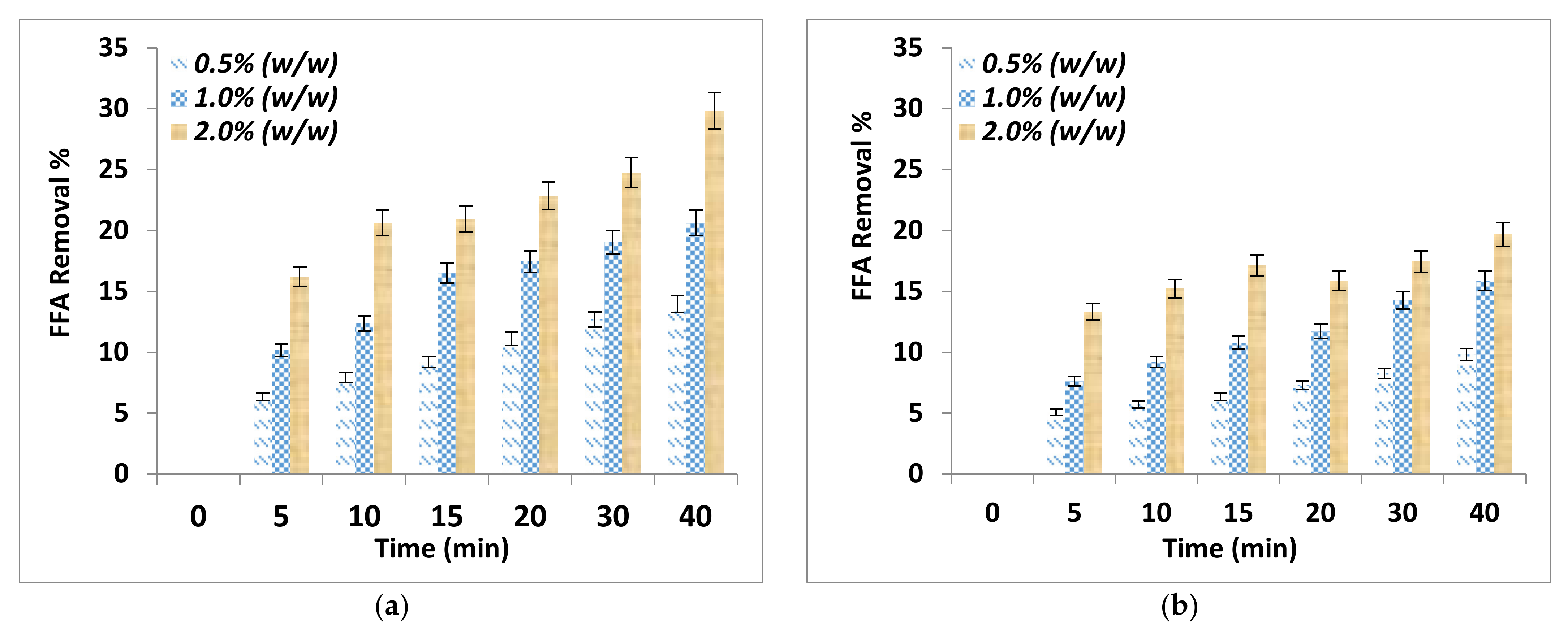
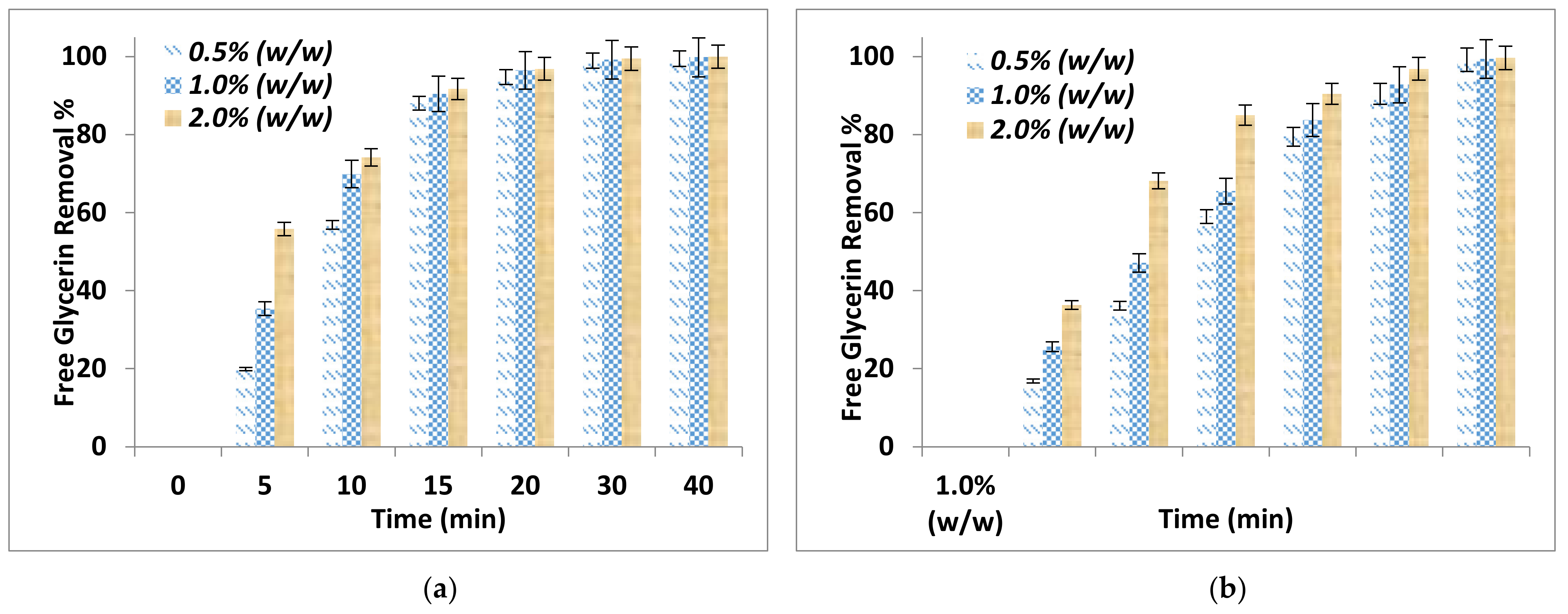
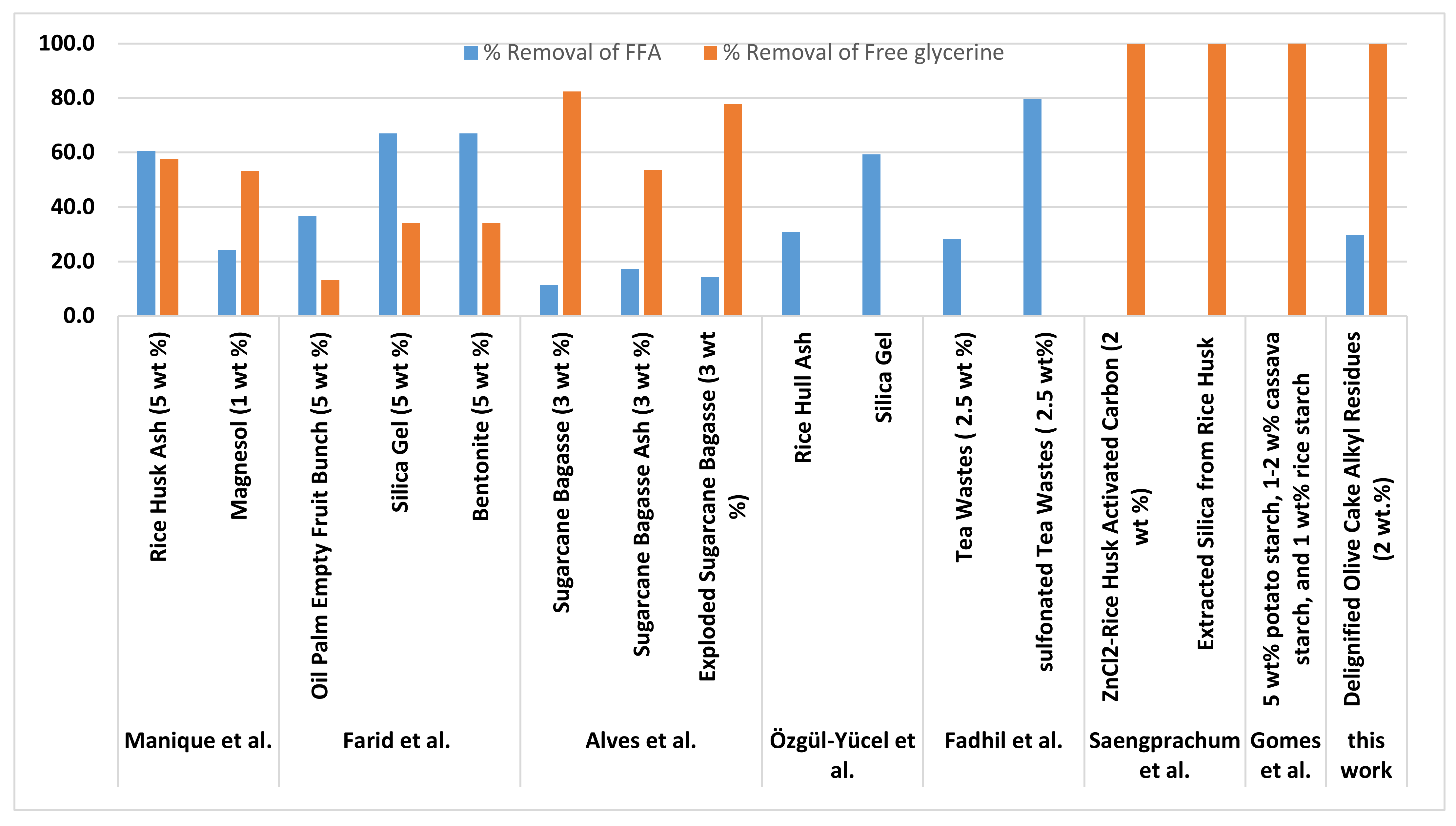
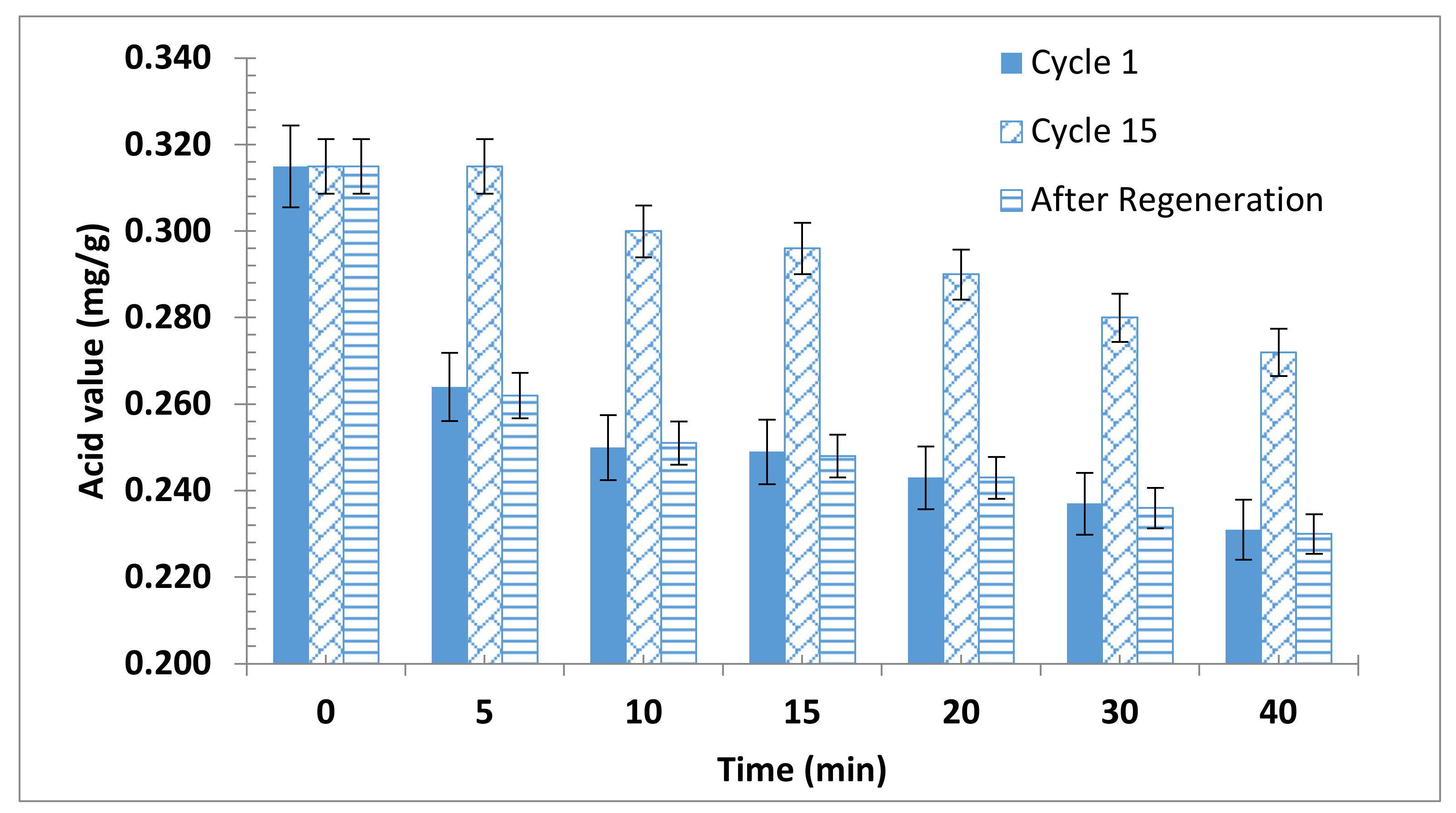
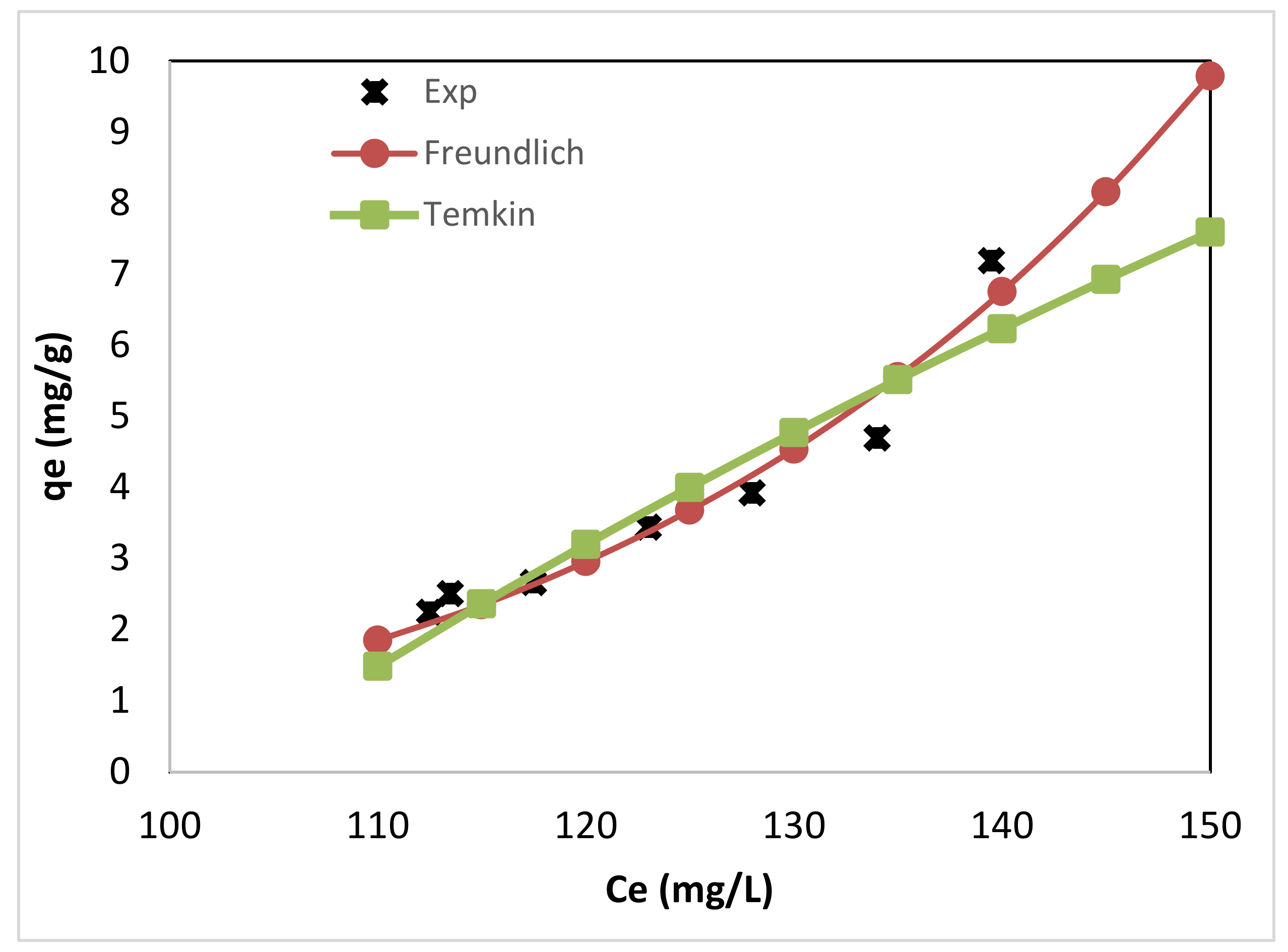
| Tested Property | Testing Procedure/Apparatus/Reference |
|---|---|
| Acid Value of biodiesel (mg KOH/g oil) | ASTM D974-97 [48] |
| Acid Value of WVO (mg KOH/g oil) | GB/T 5530-2005 [49] |
| Density (g/cm3) | Anton PAAR digital density meter DMA4100 M, Graz, Austria |
| Viscosity (cP) | ASTM test method D445 [50]/Fungilab Viscometer TSML 210045, Barcelona, Spain |
| Refractive Index | Abbe refractometer A83136 |
| Iodine value (g iodine/100 g sample) | ASTM D1959-97 (1997) [51] |
| Peroxide value (meq O2/kg oil) | IUPAC 2.501 (1992) [52] |
| Saponification value (mg KOH/g oil) | ASTM D1962-85 (1995) [53] |
| Free glycerin (mg/kg) | UV-Visible Spectrophotometer, Kent, UK [54] |
| Ash content | TAPPI T211 om-07 [55] |
| lignin content as Kalson lignin | ASTM: E1721-01 (2010) [56] |
| Moisture content | (Vicentim et al., 2010) [57] |
| Biodiesel Property | Oil | Crude Biodiesel | Alkali Residue | Water Washing | ASTM 6751 (2002) | EN 14214 (2013) |
|---|---|---|---|---|---|---|
| Yield % | - | 93 | 89 | - | - | |
| Acid Value (mg KOH/g) | 3.67 | 0.32 | 0.23 | 0.28 | 0.80 max | 0.50 max. |
| Peroxide Value(meq/Kg) | 33.6 | 29.6 | 29.0 | 29.0 | - | - |
| Iodine Value (g I2/100g) | 112.3 | 20.4 | 19.6 | 19.6 | - | 120.0 max. |
| Saponification Value (mg KOH/g) | 201 | 180 | 146 | 151 | - | - |
| Soap and Catalyst (ppm) | 0 | 0 | 0 | 0 | - | 5 max. |
| RI | 1.480 | 1.457 | 1.454 | 1.457 | - | - |
| Density (g/cm3) ± 0.0001 | 0.92 | 0.88 | 0.89 | 0.89 | - | 0.86–0.9 |
| Kinematic viscosity ± 0.01 (mm2/sec) at 40 °C | 22.4 | 7.5 | 4.0 | 5.5 | 1.9–6.0 | - |
| Free glycerin (mg/kg) | - | 0.01 | 0.00 | 0.00 | 0.02% max | - |
| Property | Spent Tea Activated Carbon | Silica Gel | Water Washing | De-Oiled Cake (Mustard Seeds) | Water Washing | Alkali Residue |
|---|---|---|---|---|---|---|
| (Fadhil, et al., 2012) | (Freundlich, 1909) | This Study | ||||
| Yield% | 97 | 93 | 88 | 94 | 84 | 93 |
| Density (g/cm3) | 0.8755 | 0.8800 | 0.8920 | 0.8889 | 0.8995 | 0.8860 |
| Viscosity (mm2/s) at 40 °C | 2.6 | 3.2 | 3.3 | 5.3 | 8.3 | 4.0 |
| Acid value (mg KOH/g) | 0.092 | 0.247 | 0.301 | 0.186 | 0.331 | 0.232 |
| RI at 20 °C | 1.445 | 1.448 | 1.457 | 1.451 | 1.457 | 1.454 |
| SV (mg KOH/g) | - | - | - | 201 | 203 | 146 |
| IV (mg I2/100 g) | - | - | - | 104 | 105 | 20 |
| Non-Linearized Isotherm | Model Parameters | χ2 | R2 |
|---|---|---|---|
| Langmuir | Not applicable (Non-positive Ka) | ||
| qm (mg/g) | |||
| Ka (L/mg) | |||
| Freundlich | |||
| Kf (L5.365/g adsorbent) | 2.076 × 10−11 | 0.203 | 0.955 |
| n | 0.186 | ||
| Temkin | |||
| bT (J/mol·K) | 125.957 | 0.466 | 0.892 |
| AT (L/g) | 0.0098 | ||
Publisher’s Note: MDPI stays neutral with regard to jurisdictional claims in published maps and institutional affiliations. |
© 2020 by the authors. Licensee MDPI, Basel, Switzerland. This article is an open access article distributed under the terms and conditions of the Creative Commons Attribution (CC BY) license (http://creativecommons.org/licenses/by/4.0/).
Share and Cite
Alnaief, M.; Sandouqa, A.; Altarawneh, I.; Al-Shannag, M.; Alkasrawi, M.; Al-hamamre, Z. Adsorption Characteristics and Potential of Olive Cake Alkali Residues for Biodiesel Purification. Energies 2021, 14, 16. https://doi.org/10.3390/en14010016
Alnaief M, Sandouqa A, Altarawneh I, Al-Shannag M, Alkasrawi M, Al-hamamre Z. Adsorption Characteristics and Potential of Olive Cake Alkali Residues for Biodiesel Purification. Energies. 2021; 14(1):16. https://doi.org/10.3390/en14010016
Chicago/Turabian StyleAlnaief, Mohammad, Arwa Sandouqa, Ibrahem Altarawneh, Mohammad Al-Shannag, Malek Alkasrawi, and Zayed Al-hamamre. 2021. "Adsorption Characteristics and Potential of Olive Cake Alkali Residues for Biodiesel Purification" Energies 14, no. 1: 16. https://doi.org/10.3390/en14010016
APA StyleAlnaief, M., Sandouqa, A., Altarawneh, I., Al-Shannag, M., Alkasrawi, M., & Al-hamamre, Z. (2021). Adsorption Characteristics and Potential of Olive Cake Alkali Residues for Biodiesel Purification. Energies, 14(1), 16. https://doi.org/10.3390/en14010016






